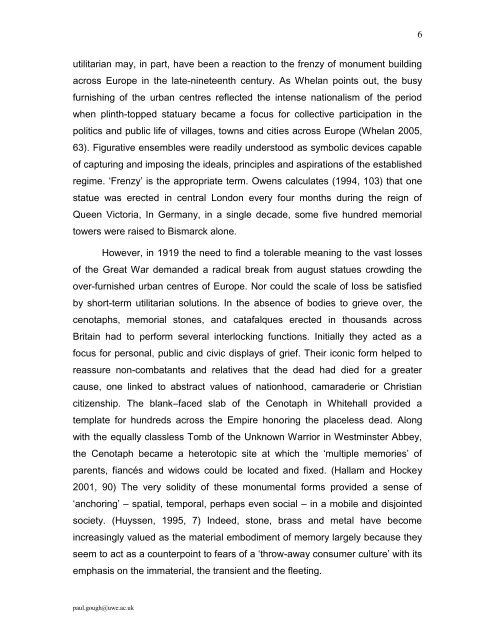Gough, P. (2008) Commemoration of war. In: Graham, B. and ...
Gough, P. (2008) Commemoration of war. In: Graham, B. and ...
Gough, P. (2008) Commemoration of war. In: Graham, B. and ...
You also want an ePaper? Increase the reach of your titles
YUMPU automatically turns print PDFs into web optimized ePapers that Google loves.
utilitarian may, in part, have been a reaction to the frenzy <strong>of</strong> monument building<br />
across Europe in the late-nineteenth century. As Whelan points out, the busy<br />
furnishing <strong>of</strong> the urban centres reflected the intense nationalism <strong>of</strong> the period<br />
when plinth-topped statuary became a focus for collective participation in the<br />
politics <strong>and</strong> public life <strong>of</strong> villages, towns <strong>and</strong> cities across Europe (Whelan 2005,<br />
63). Figurative ensembles were readily understood as symbolic devices capable<br />
<strong>of</strong> capturing <strong>and</strong> imposing the ideals, principles <strong>and</strong> aspirations <strong>of</strong> the established<br />
regime. „Frenzy‟ is the appropriate term. Owens calculates (1994, 103) that one<br />
statue was erected in central London every four months during the reign <strong>of</strong><br />
Queen Victoria, <strong>In</strong> Germany, in a single decade, some five hundred memorial<br />
towers were raised to Bismarck alone.<br />
However, in 1919 the need to find a tolerable meaning to the vast losses<br />
<strong>of</strong> the Great War dem<strong>and</strong>ed a radical break from august statues crowding the<br />
over-furnished urban centres <strong>of</strong> Europe. Nor could the scale <strong>of</strong> loss be satisfied<br />
by short-term utilitarian solutions. <strong>In</strong> the absence <strong>of</strong> bodies to grieve over, the<br />
cenotaphs, memorial stones, <strong>and</strong> catafalques erected in thous<strong>and</strong>s across<br />
Britain had to perform several interlocking functions. <strong>In</strong>itially they acted as a<br />
focus for personal, public <strong>and</strong> civic displays <strong>of</strong> grief. Their iconic form helped to<br />
reassure non-combatants <strong>and</strong> relatives that the dead had died for a greater<br />
cause, one linked to abstract values <strong>of</strong> nationhood, camaraderie or Christian<br />
citizenship. The blank–faced slab <strong>of</strong> the Cenotaph in Whitehall provided a<br />
template for hundreds across the Empire honoring the placeless dead. Along<br />
with the equally classless Tomb <strong>of</strong> the Unknown Warrior in Westminster Abbey,<br />
the Cenotaph became a heterotopic site at which the „multiple memories‟ <strong>of</strong><br />
parents, fiancés <strong>and</strong> widows could be located <strong>and</strong> fixed. (Hallam <strong>and</strong> Hockey<br />
2001, 90) The very solidity <strong>of</strong> these monumental forms provided a sense <strong>of</strong><br />
„anchoring‟ – spatial, temporal, perhaps even social – in a mobile <strong>and</strong> disjointed<br />
society. (Huyssen, 1995, 7) <strong>In</strong>deed, stone, brass <strong>and</strong> metal have become<br />
increasingly valued as the material embodiment <strong>of</strong> memory largely because they<br />
seem to act as a counterpoint to fears <strong>of</strong> a „throw-away consumer culture‟ with its<br />
emphasis on the immaterial, the transient <strong>and</strong> the fleeting.<br />
paul.gough@uwe.ac.uk<br />
6
















